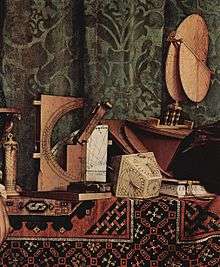Torquetum

The torquetum or turquet is a medieval astronomical instrument designed to take and convert measurements made in three sets of coordinates: Horizon, equatorial, and ecliptic. In a sense, the Torquetum is an analog computer.
The first torquetum is thought to have been built by Jabir ibn Aflah (Geber)[1] in the 12th century or 13th century,[2] though the only surviving examples date from the 16th century.

A torquetum can be seen in the famous portrait The Ambassadors (1533) by Hans Holbein the Younger. It is placed on the right side of the table, next to and above the elbow of the ambassador clad in a long brown coat or robe. The painting shows much of the details of the inscriptions on the disk and half disk, which make up the top of this particular kind of torquetum.[3]
A 14th century instrument, the rectangulus, was invented by Richard of Wallingford. This carried out the same task as the torquetum, but was calibrated with linear scales, read by plumb lines. This simplified the spherical trigonometry by resolving the polar measurements directly into their Cartesian components.
See also
- Astronomical clock
- Antikythera mechanism
- Armillary sphere
- Astrolabe
- Orrery, a free-standing solar system model
- Planetarium
- Prague Orloj
- Celestial sphere
Notes and references
- ↑ Lorch, R. P. (1976). "The Astronomical Instruments of Jabir ibn Aflah and the Torquetum". Centaurus. 20 (1): 11–34. Bibcode:1976Cent...20...11L. doi:10.1111/j.1600-0498.1976.tb00214.x.
- ↑ Thorndike, Lynn (October 1945). "Franco de Polonia and the Turquet". Isis. 36 (1): 6–7. doi:10.1086/347897. JSTOR 225669.
- ↑ Dekker, Elly; Kristen Lippincott (1999). "The Scientific Instruments in Holbein's Ambassadors: A Re-Examination". Journal of the Warburg and Courtauld Institutes. The Warburg Institute. 62: 93–125. doi:10.2307/751384. ISSN 0075-4390. JSTOR 751384.
- Ralf Kern: Wissenschaftliche Instrumente in ihrer Zeit. Vom 15. – 19. Jahrhundert. Verlag der Buchhandlung Walther König 2010, ISBN 978-3-86560-772-0